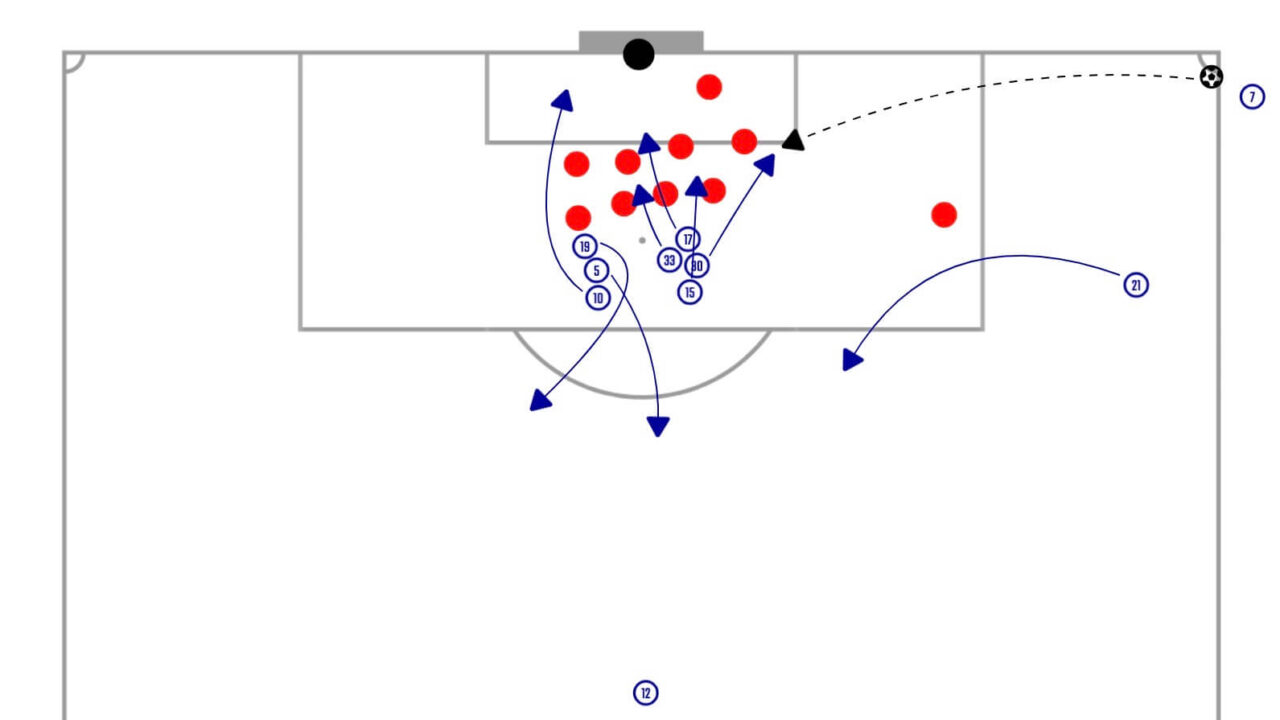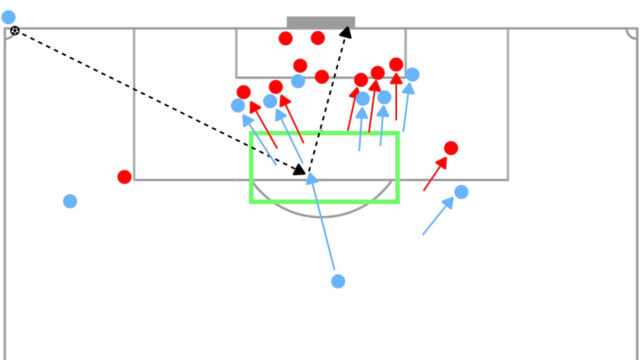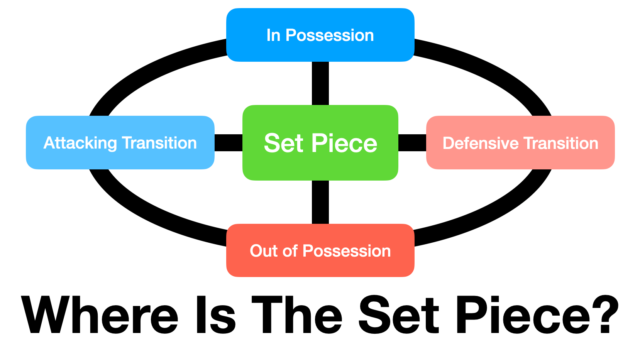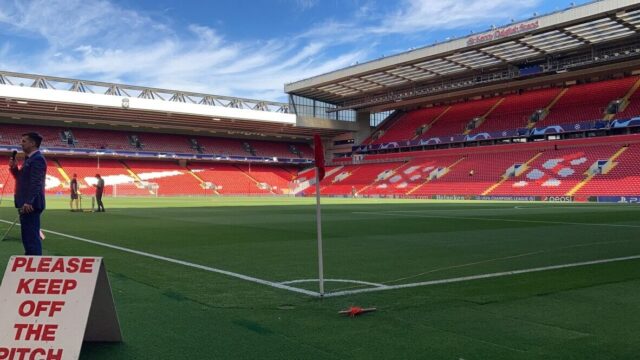Introduction
In this article, the set pieces tactics of Tottenham Hotspur in first five Premier League games are going to be analysed. Before this season began, Spurs appoint Gianni Vio to a set pieces coach, who helped Italy to win EURO 2020. Obviously, Spurs have already secured some points by the goals from set pieces in this season, so it is possible to say that he is doing great job so far. Therefore, it is worth analysing the set pieces tactics of Spurs to understand what kinds of ideas Gianni Vio brought to Spurs. Let’s begin analysing tactics of corner kicks.
Attacking Corner Kicks
MD 1 vs Southampton
This is the first game of the season, so the basic information is going to be noted here. The player who takes corner kicks is basically right-footed Son Heung-Min, so the ball is delivered with out-swing from the right side and in-swing from the left side. Kulusevski sometimes picks the ball up but he plays it short.
In the case when both out-swing and in-swing balls are delivered, the pattern of movements in the box often varies. Spurs followed this and used different set up depending on the type of delivery. Firstly, the set up when the ball was played with out-swing is going to be discussed. By the way, Saints defended corner kicks with total zonal marking.

This illustration shows how Spurs players moved in the corner kick taken in four minutes in the first half. Considering the feature of the out-swing delivery, it is very effective to run and attack the ball curving towards the attacking player, which can give the header more power. Thus, Players of Spurs were positioned behind the penalty spot to have space to dive.
Then, the most interesting thing is placing seven players in the box and no players were around the D to manage the second balls. A lot of teams usually have some players on the edge of the box to win the ball cleared by a defender, but Spurs didn’t when they initially positioned themselves. However, as soon as Son raised his left hand above his head, three players including a player offering a passing lane to play short moved towards the outside of the box to prepare for the second balls. After they were ready, Son delivered the ball. But, why they did’t place these players until the kicker took the corner kick? Some reasons of this are to disguise the number of players to dive or forcing the opposition to have more players come back to prevent them from leaving some attackers up front. To be fair, however, same players moved back every time so it looked like useless.
Then, the ball was delivered to the first post every time. This is not the strategy for this game but for all games that at least I analysed. The main target player is Eric Dier (15) and he dives into the space where another player running towards the edge of the six-yard box creates by dragging some defenders out.

As it is shown in the illustration above, if one of the attackers moves towards the edge of the six-yard box, some of the opposition players defending the space around the first post often step forward to make a contact to the attacker. Therefore, the distance between the defenders at the near side and in the middle is stretched and there will be a space for a player to head the ball without any contacts.
Then, let’s take a look at the organisation when the ball is delivered with in-swing.

This is the corner kick in 31 minutes in the first half and resulted in the goal scored by Dier from the cross after securing the second ball. The aim of the area where the ball was delivered was still the near side again. However, the system in the box was different because the ball was delivered with in-swing this time. When out-swing balls, they tried to head the ball with diving towards the ball, but it is enough to flick the ball and change the direction of the ball little bit with in-swing balls. Additionally, this time Saints defended with total zonal marking, so players appeared in front of each defender from their blind side, which makes it easier for attackers to head the ball before a defender clears it. Therefore, four players were positioned around the opposition goalkeeper, where is the blind side of defenders around the near side, while another three players performed same routine.
MD 2 vs Chelsea
I mentioned that Son is ‘basically’ the player to take corner kicks. However, the trickiest one is Perišić who can deliver the ball by both feet with high accuracy. In this game against Chelsea, the delivery of the ball was in-swing from both sides after Perišić came on the pitch. Additionally, not only the type of delivery but also the patterns of movements were same throughout the game. Consequently, Spurs could equalise in the added time.

This is the routine when Kane scored the equaliser. The characteristic of the defensive organisation of Chelsea was five players defending around the six-yard box and Jorginho man-marking Dier. As it was mentioned previously, Dier (15) and Davies (33) popped up the near side from the blind side of defenders. Flicking the ball by Dier in the near side could be an option, but the goal was scored behind him.

Usually, Davies acts as a dummy to open up the space between defenders in order to let Dier head the ball in the space. However, this time Dier was also dummy to remove Jorginho from the middle to give a space for Kane or other players to head the ball. As Koulibaly stepped back to cover the goal, the connection between defenders was completely broken and not only Kane but also Richarlison (9) or Moura (27) could have headed the ball in a huge space.
Throughout the game, Spurs kept using same routine and finally scored the goal. In many cases, the ball was kicked towards DIer in the near side, but the goal was scored from Kane in the middle. It is impossible to know which one was the main target unless asking Vio, but it is possible to say that Spurs had at least two patterns to score in a routine.
Spurs often use same routine throughout a game and the ball keeps being delivered towards the near side. Some teams try to use as many patters as they have to confuse defenders, but Spurs are doing completely the opposite thing. However, the routine performed by Spurs is planned well to exploit the weakness of the opposition teams, so by keeping using the same but most effective pattern throughout 90 minutes, they can maximise the probability to score goals rather than gambling every time.
MD 3 vs Wolverhampton Wanderers
In the game against Wolves, the first corner kick was taken with out-swing but rest of them were in-swing by Son and Perišić. Wolves defended with man-marking, but they had two players around the first post. Therefore, how to head the ball at the near side was same as against teams defending zonal marking, which is that one of the attackers running towards the edge of the six-yard box to draw defenders out and Dier uses the space. Then, other players tried to lose their marker and ran towards the near side but only Kane moved away towards the back post.

Spurs always try to use the space in the near side and players flick the ball there. However, if the ball is flicked with less power than necessary, it will move away from the goal. In order to tap or head this kind of ball in, at least one player needs to be around the back post and it is often Kane.
The most important thing is not to be at the back post but to arrive there in the best timing. Against teams defending man-marking like Wolves, Kane uses the opposite movement to lose his marker as shown in the illustration above. On the other hand, against zonal marking, running toward the back post from a distance can be effective.
MD4 vs Nottingham Forest
In the game against Forest, Spurs could earn only a corner kick but they conceded a counterattack from that corner kick. Thus, how to manage counterattacks from corner kicks is going to be discussed here.

Teams defending corner kicks like Wolves often have two spare players around the first post. Thus, the defensive teams can only mark eight players of nine attackers as they don’t need to mark the kicker. Consequently, attacking team can have a spare player and he often stays around the halfway line to defend counterattacks. This is the rationale why the theory of having one more player to manage the opposition attacker staying high can be practical. However, Forest had only a spare player at the near post so they could mark all nine players. Additionally, they left two players high up the pitch but Spurs couldn’t have a spare player to manage this. Thus, it is impossible to keep the theory against Forest.
Additionally, the worst thing was that the ball delivered by Son was caught by the goalkeeper because this can be the trigger to play a counterattack. Defending counterattacks from attacking corner kicks are difficult because the centre backs or strong defensive midfielder who always manage the counterattack in open play are absent and small fullbacks or attackers need to defend against the opposition attackers. However, I think Spurs could defend against the counterattack well. Not the best but better.
The counterattacks played by Forest was horizontal. Many players moved horizontally and swapping the lane each other. The aim of this is that attackers are man-marked, so changing each position horizontally can confuse the opposition defenders or make a gap between them. However, Spurs’ players came back straight towards the own goal with swapping the opposition attackers to mark. Therefore, more players of Spurs could arrive the box earlier than attackers of Forest, who used horizontal movements a lot.
MD5 vs West Ham
Against West Ham, there was nothing special. All of the ball delivered was cleared by a defender at the near side so there were no successful corner kicks.

West Ham defended with zonal marking and placed six players in the six-yard box. Therefore, they tried to pop up in front of them from the blind side but they used both in-swing and out-swing.
Overall, Spurs try to deliver the ball to the near side. Davies or Bentancur opens the space for Dier to head the ball and Kane runs towards the back post to tap the ball moving away from the goal in. In terms of the structure, Spurs use the movements of running and diving towards the ball from a distance with out-swing balls, while they use the movements of popping up in front of the defenders from their blind side with in-swing balls.
Defending Corner Kicks
In defending corner kicks, basically they defend each space so it can be described as zonal marking. The set up is that a player in front of the first post, four players in a diagonal line around the line of the six-yard box and three players in a line in front of the line of four players. Emerson or Sessegnon stands in front of the first post, Højbjerg, Kane, Dier and one of the defensive midfielders or wingbacks are in the line of four and Davies, the rest of the centre backs and one of the defensive midfielders or wingbacks are in the line of three. Son and Kulusevski play a role of marking the opposition players offering a passing lane to play short or standing between the penalty spot and the D to manage the second balls.
If the second ball was secured by Spurs’ player, they will play a counterattack. Both second strikers and Højbjerg often join the counterattack.

This is the example of the counterattack against Chelsea in 41 minutes in the first half. It ends with the opposition committed a foul but the counterattack after defending corner kicks is one of their threats.
So far, they haven’t conceded any goals from corner kicks but what is the weakness of them? The team who tried to exploit it was Forest.

As it is shown in the illustration above, they used straight balls towards the far side and headed it back to in front of the goal. This is very effective to exploit the weakness of the structure. Against zonal defending of Spurs, diving towards the ball can give more power in the aerial duel with a defender standing still. Additionally, the defenders of Spurs need to step back to clear the ball delivered towards the far side, which also makes it easier for the opposition to win the aerial duel. Therefore, lots of teams will try this to score from corner kicks against Spurs.
Free Kicks
In this chapter, the tactics of free kicks are going to be analysed. However, the sample size is small so maybe they will perform other variations in the future.
Attacking FK in Deeper Areas
The strategy in attacking free kicks in a deeper area can be similar to the strategy of corner kicks.

This is the example of the free kick against Wolves. Against zonal defending, popping up in front of defenders from their blind side or Perišić moving towards the edge of the six-yard box to oepn up the space are similar tactics used in corner kicks. There was another free kick in a deeper area against Chelsea and the ball was still delivered towards the near side again. Since the illustration could be mess, some arrows were removed, but the three players who don’t have each arrow in the box also moved towards the near side.
Defending FK in Deeper Areas
The differences between free kicks and corner kicks are the wall and offside rule.

This is the example of defending free kicks against Saints. The player on the wall is Sessegnon who was in front of the first post in defending corner kicks. The back line consists of five players, who are the same four players in defending corner kicks and Bentancur between Kane and Dier. Additionally, the two players of the three players without Bentancur defend in front of the back line with marking the opposition players. However, this may be used only in this game because they marked the opposition players in defending corner kicks against only Saints.
Attacking FK in front of the Box
Then, the tactics in attacking free kicks in front of the box are going to be discussed here.

In this game against Chelsea, as it was mentioned previously, in-swing was the key factor and right-footed Son delivered the ball with left foot in this example. The ball went over the goal this time but the aim would be the ball which can be head at the near side and tapped in at the back post. Bentancur and Romero ran straight towards the back post area and Dier did same thing in the middle. On the other hand, at the near side, Davies and Højbjerg blocked the opposition defenders and Kane made a curved run towards the first post.
The aim of this effort at the near side is that most of unsuccessful free kicks are cleared at the near side, but if the ball can go past the defenders at the near side, the probability of the ball shot by attackers can be high and defenders are forced to clear the ball with running towards their own goal. Therefore, blocking the opposition defenders at the near post is important.
Defending FK in front of the Box
Lastly, defending free kicks in front of the box is going to be analysed.

The back line consists of seven players who are in the line of four and three in defending corner kicks and rest of them play a role of the wall and securing the second balls.
The hight of the back line is little bit deeper than the wall and stats to running back to their own goal as soon as the kicker starts to run up. After clearing the ball, they push up the line around between the penalty spot and the 18-yard box line. Overall, they don’t want to take a risk by pushing up the line aggressively to use the offside rule. Additionally, Dier instructs other players to push the line up but most of all often focus on marking their marker rather than pushing up the line.
Conclusion
Gianni Vio, who is known as having 4,830 patterns in set pieces looks like doing simple thing at Spurs. They are not using lots of patterns but focusing on a routine which can exploit the weakness of the opposition team. So far, Spurs could secure some points such as in the game against Wolves or Chelsea, so Vio could successfully make an impact. It is interesting to see what he will do after the opposition teams become able to plan the tactics against Spurs.




